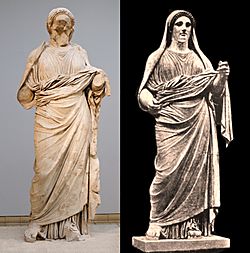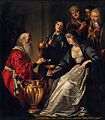Artemisia II of Caria facts for kids
Quick facts for kids Artemisia II |
|
|---|---|

Original and reconstitution of the statue traditionally identified as Artemisia, from the Mausoleum at Halicarnassus, now in the British Museum.
|
|
| Satrap of Caria | |
| In office | 353–351 BCE |
| Predecessor | Mausolus |
| Successor | Idrieus |
| Born | c. 395 BCE. |
| Died | c. 351 BCE. |
| Consort | Mausolus |
| House | Hecatomnids |
| Father | Hecatomnus |
| Mother | unknown |
| Religion | Greek polytheism |
Artemisia II of Caria was a powerful ruler from Ancient Greece. She was a skilled naval strategist and commander. Artemisia became the ruler of Caria after her brother and husband, Mausolus, passed away. Mausolus was a satrap (a kind of governor) for the Achaemenid Empire. He was treated like a king.
Artemisia ruled for two years, from 353 to 351 BCE. When she became queen, some cities under her control rebelled. They did not want a woman to rule them. But Artemisia managed her kingdom just like her husband did. She especially supported the wealthy families on the island of Rhodes. Artemisia was also known for her deep sadness after Mausolus died. She showed her grief in very unusual ways. Later, people saw her as a symbol of true love and loyalty.
Contents
Who Was Artemisia II?
Artemisia is famous in history for her extreme grief after her husband, Mausolus, died. People say she mixed his ashes into her daily drink. She slowly became weaker during the two years she lived after him. She also hired the best Greek speakers to praise him in their speeches.
Building the Mausoleum
To honor Mausolus, Artemisia built the famous Mausoleum at Halicarnassus. This building was so grand that it became one of the Seven Wonders of the Ancient World. Its name, "Mausoleum," later became a general term for any magnificent tomb.
Artemisia's Military Skills
Artemisia was a strong leader who commanded her own fleet of ships. She played a key role in the military events around the Aegean Sea. This was especially true after Athens lost its strong navy.
The Conflict with Rhodes
The island republic of Rhodes did not like that a woman was ruling Caria. So, Rhodes sent its fleet to attack Artemisia. However, they did not know that her late husband had built a secret harbor.
Artemisia cleverly hid her ships, rowers, and marines. She allowed the Rhodian ships to enter her main harbor. Artemisia and her people then met the Rhodians at the city walls. They invited them into the city.
As the Rhodian soldiers started to leave their ships, Artemisia acted. She sailed her hidden fleet through a secret exit into the main harbor. She captured the empty Rhodian ships. The Rhodian men who had gone into the city were killed in the marketplace.
After this victory, Artemisia put her own soldiers on the captured Rhodian ships. She sent them sailing back to Rhodes. The people of Rhodes welcomed these ships, thinking they were their own. Artemisia's men then took control of Rhodes.
Another Clever Plan
A writer named Polyaenus wrote about another smart move by Artemisia. He said that when Artemisia wanted to conquer the city of Latmus, she hid her soldiers near the city. Then, she, along with women, eunuchs, and musicians, held a religious ceremony. This ceremony was in a sacred grove about seven stades (a unit of distance) from the city.
When the people of Latmus came out to watch the grand procession, Artemisia's hidden soldiers entered the city. They took control of it easily.
Other Monuments
Artemisia also built another famous monument in Rhodes. This was to celebrate her conquest of the island. After the Rhodians gained their freedom back, they made this monument impossible to reach. Because of this, it was later called the Abaton (meaning "inaccessible").
Images for kids
-
Master Of The Story Of Griselda, Siena, 15th century, one of a series of heroes and heroines who behaved well to the opposite sex.
-
Rembrandt, about 1634 CE.
-
Gerrit van Honthorst, about 1635 CE, Princeton University Art Museum.
-
Johann Heinrich Tischbein, 1775 CE, Portrait of Countess Augusta Reuss of Ebersdorf, Queen Victoria's grandmother, as Artemesia.
-
Schönbrunn Palace, Vienna, 1773–1780 CE.
-
Statue of Artemisia II in Versailles.
See also
 In Spanish: Artemisia II de Caria para niños
In Spanish: Artemisia II de Caria para niños











